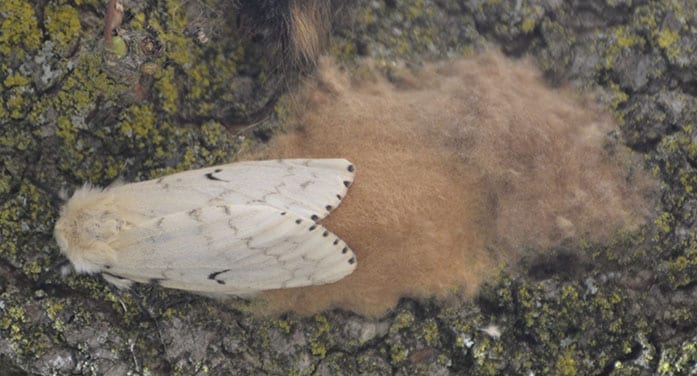 This seems to be a good year for gypsy moths and a bad one for people who love trees.
This seems to be a good year for gypsy moths and a bad one for people who love trees.
Have you never seen a gypsy moth? This might be the best time to find them. Look for a light to dark brown, medium-sized moth flying in a seemingly erratic way. These are the males. They’re sniffing the wind while being drawn to the females by pheromones they release.
But let’s talk about how they got here and why we care before we delve more into their eruptive life cycle.
Gypsy moths were accidentally released near Boston in 1868 and spread throughout much of northern and west-central United States and central and eastern parts of Canada.
There were few predators to stem their expansion since many birds and other organisms hadn’t developed mechanisms to feed on them yet.
In the 1970s and 1980s, they were a huge problem as they emerged in the millions in many areas, including Ontario and much of eastern North America. Huge swarms of gypsy moths could be seen feeding on virtually any type of tree but favouring maple, oak and aspen.
Gypsy moths are called an outbreak species and may be present for two or three years in large numbers, then seemingly disappear. Longer emergence events are most devastating to trees. As trees are defoliated year after year, they weaken and can die, or other diseases and insects can attack them.
But gypsy moths rarely seem to cause the widespread fatal damage that the emerald ash borer causes.

Female Gypsy Moth with egg mass
The female is white with small black flecks on the wings and is flightless. Soon you will see her on the bark of a tree with a pale sandy-coloured, fuzzy mass underneath her. This mass is her eggs – 100 to 1,000 of them – and they will survive the winter.
In April, they hatch and start to disperse by a mechanism known as ballooning, where they move to the ends of branches and let the wind carry them to a food tree.
They grow rapidly, shedding their skin several times (five times in males and six in females) as they get larger over the next six to seven weeks.
The newly-hatched caterpillars are small and often overlooked. They’re grey, with small tufts of hair along their sides and several pairs of dots (tubercles) on their dorsal surface, which are blue towards the head and red along the middle and rear of the back.
As the caterpillars grow larger, they may start feeding more during the day, and that’s when we often notice them.
Finally, they enter a pupal stage near the host trees, choosing rocks, tree trunks, buildings and other hidden places. They transform over the next 10 to 14 days into adult moths and then carry out the reproductive part of their life cycle.
From a human perspective, they can be irritating because of the damage they do and because caterpillar hairs can irritate our skin.
So what should you do?
This is tricky and really depends on the value you put on your trees and the environment in general. Most healthy deciduous trees can survive one or two seasons of heavy defoliation, so doing nothing can be an option. That’s beneficial to other wildlife because many birds and other animals now feed on them. I did a study in the 1970s and found over 70 species of birds feeding on the larvae in the Peterborough, Ont., area.
Insects are already in serious decline throughout the world, so killing insects for the sake of killing them seems ill-advised. The use of insecticides is indiscriminate and will kill many beneficial insects as well.
Many biological organisms – from parasitic wasps, fungal and viral pathogens, to birds, mice and shrews – are doing their part to stem the spread naturally, so nature is hard at work.
Each of us will have to decide what to do. I’ll let them live and be part of my ecosystem.
Geoff Carpentier is a published author, expedition guide and environmental consultant. Visit Geoff online at www.avocetnatureservices.com, on LinkedIn and Facebook.
The views, opinions and positions expressed by columnists and contributors are the authors’ alone. They do not inherently or expressly reflect the views, opinions and/or positions of our publication. © Troy Media
Troy Media is an editorial content provider to media outlets and its own hosted community news outlets across Canada.


